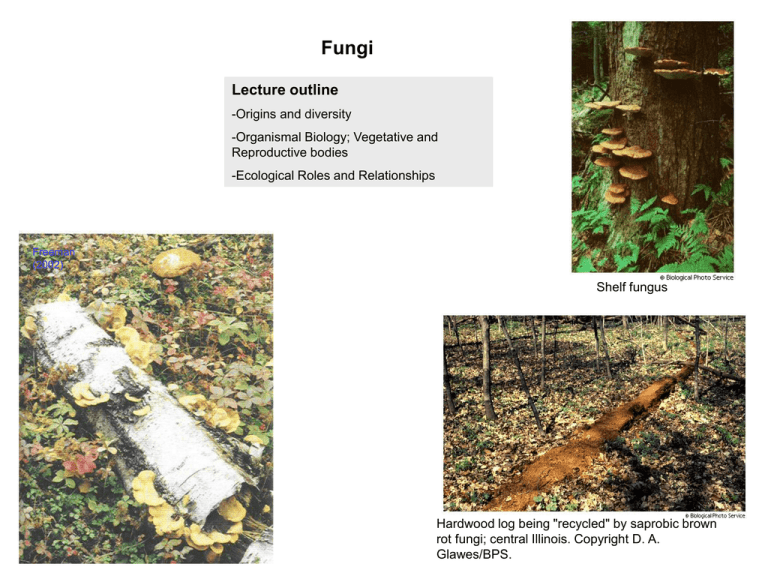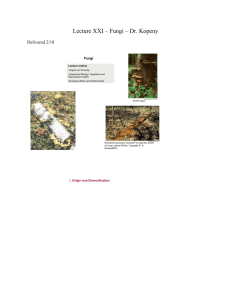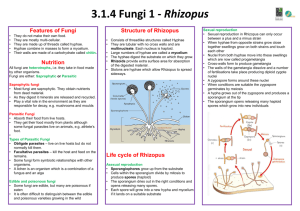Fungi Lecture outline
advertisement

Fungi Lecture outline -Origins and diversity -Organismal Biology; Vegetative and Reproductive bodies -Ecological Roles and Relationships Freeman (2002) Shelf fungus Hardwood log being "recycled" by saprobic brown rot fungi; central Illinois. Copyright D. A. Glawes/BPS. I. Origin and Diversification Freeman (2002) Fungi diverged at least 600 mya from a Protistan ancestor Fungi and animals share a recent common ancestry Fungi are all asborptive heterotrophs Many are saprobes (decomposers) Many are parasites or pathogens Many exist as symbiotic mutualists - mycorrhizal association with vascular plant roots, lichens Fruiting body (mushroom) of the reddening lepiota (Lepiota americana), showing gills. Copyright Barbara J. Miller/BPS. Growing under snow, the mycelium of snow mold (Typhula sp.) kills turf grass. Copyright BPS. Brewer's or baker's yeast, the hemiascomycete Saccharomyces cerevisiae. LM. Copyright James Solliday/BPS. Two life forms in Fungi - unicellular species - species with vegetative bodies composed of hyphae vegetative structure; mycelia, network of hyphae fruiting bodies eg, mushroom common protistan ancestor Chytridiomycota motile gametes and spores Zygomcyota make zygote with tough coat loss of flagella Ascomycota sac-like ascus Basidiomycota pedestal-like basidium These four phyla are distinguished based on reproductive structures Most are unicellular , some form coenocytic (multinucleate) hypahe; parasitic or saprobic; unique fungal traits; mainly aquatic, flagellate gametes, and chitinous cell walls most are soil-inhabiting, many are plant mutualists; of major importance as mycorrhizal mutualists; ~600 spp. Diverse lineage; freshwater, marine and terrestrial; includes yeasts, cup fungi; serious plant pathogens and saprobes. About half are algae mutualists; some form plant mycorrhizae. Some are mutualists in leaf tissue.; molds; 60,000+ spp important wood saprobes, incl. lignin; incl. mycorrhizae-forming plant mutualists, and plant pathogens --rusts and smuts; includes familiar mushrooms, shelf fungi, puff balls; 25,000+ spp. “Imperfect fungi” - 65,000 spp. whose phylogenetic postion in Fungi is undetermined, have secondarily lost a sexual reproductive phase Distinctive lifestyles and ecological types (eg, molds, yeast, mycorhizzal mutualists…) occur across lineages Cladogram indicating probable phylogenetic relationship among four phyla of Fungi, supported mainly by molecular evidence. chytridiomyctota (chytrids). The zygomycete Pilobus decomposes animal dung The common mold Rhizopus decomposing strawberries Edible morel (Morchella esculenta). Copyright Dr. Phil Gates, Durham U./BPS. Scarlet cups (Sarcoscypha coccinea). Copyright BPS Keeton and Gould 1993 puffball Scarlet hood (Hygrocybe coccinea) is native to northern Europe and North America. The tissue above ground are the reproductive structures -- most of the organism is underground (Freeman (2002) Organismal Biology: Vegetative and Fruiting Bodies, and life cycles Source: Campbell et al (2002) The mushroom is a reproductive structure that produces spores The above-ground , visible (mushroom) is comprised of hypae and is continuous with the less visible hyphae (near and below the ground in this case) Mushrooms grow each fall from the mycelium beneath sporeproducing structures A fungal mycelium grows from a spore that germinated in a suitable habitat Vegetative part of a mycelium (white, threadlike) decomposing brown confer needles Vegetative (feeding) body of fungi other than yeast consists of a nearly microscopic tubular filaments that grow in a network like mycelium In most species, hyphae are multi-nucleate - either coencytic or septate; not multicellular; septa are porous to organelles Mycelium of a fungus feeding on leaves in a Maryland forest (Raven et al 2002) Septum in a vegetative hypha of Drechstera sorokinianum; pore. TEM. Copyright Dr. Garry T. Cole, University of Texas/BPS. Cellulose is the most common carbohydrate on earth. It’s a highly insoluble, unbranched polysaccharide used by plants as their major supporting material. Chitin is the polysacharride that serves as the major structural component of insect exoskeletons and fungal cell walls, and is functionally equivalent to cellulose. Cellulose is composed of long chains of beta linked glucoses. Chitin is composed of beta linked acetylglucosamines (glucoses with a combined acetyl-amino side group) Cellulose Chitin Hyphae show various adaptations to different lifestyles Predatory fungus with hyphae adapted for trapping and killing prey. Portions of the hyphae in this soil fungus (Arthrobotrys) are modified into constricting loops; constriction is stimulated by worm touching inside of loop. Constriction occus in less than a second. Fungus then penetrates worm with hyphae and digests inner tissues. (Campbell 2002) Armillaria is a pathogenic fungus. It is shown here affecting three areas of coniferous forest in Montana. Spore release from pathogenic poplar rust Heterokaryotic Stage Spore-producing structures Spores Asexual Reproduction Germination Karyogamy (fusion of nuclei) Plasmogeny (fusion of cytoplasm) Sexual Reproduction Mycelium Germination Haploid Heterokaryotic (unfused nuclei form different parents) Diploid (2n) Zygote Zygote Meiosis Spores Spore-producing structures Generalized Life Cycle of Many Fungi (sexual phase absent in some species) (after Campbell 2002) Keeton & Gould 1993 Above Spherical sporangia on hyphae -black ones are ripe Left Close up (asexual reproduction) -- hyphae are ~1 cm Sexual reproduction in the common bread mold (a Zygomycete). Raven et al 2002 Fusion of gametangia of black bread mold (Rhizopus stolonifer); septum present Fused gametangia of black bread mold (Rhizopus stolonifer); septum dissolving Zygote (zygosporangium) resulting from fused gametangia of Rhizopus stolonifer. LM. Two zygosporangia of Rhizopus stolonifer: resistant zygospores. LM. Sexual reproduction in the common bread mold (a Zygomycete). III. Ecological Roles and Relationships Source: Freeman 2002 CO2 from degradation of lignin Atmospheric CO2 Assimilation of CO2 by plants CO2 from plant and animal respiration Fungal mycelia Glucose from degradation of cellulose transferred to fungivores like insect larvae, ants and squirrels The action of Fungi that digest lignin and cellulose is a major determinant of the global cycling of Carbon Percentage of fungal fossils Source: Freeman 2002 The spike in fungal fossils at the end permian extinction corroborates the hypothesis that terrestrial ecosystems, not only marine systems, experienced mass extinctions; the spike suggests fungi that decompose wood proliferated with the massive die-off of trees Hyphae of the fungus Pisolithus tinctorius form an ectomycorrhiza on the root of a eucalyptus. SEM. Copyright R. L. Peterson, Univ. Guelph/BPS. Source: Solomon et al 2002 The chestnut blight fungus, an Ascomycete, was introduced in New York early in the 20th century; by mid century it had killed almost all Chestnut trees in North America Extra slides I. Evolutionary History of Fungi III. Ecological Roles and Relationships Dictyospores (resting spores) of the nematode-pathogenic deuteromycete Diheterospora chlamydosporia. LM. Copyright D. A. Glawes/BPS. solomon 2002 p 534 24 Sporangiophores of Phycomyces sp. Copyright J. Robert Waaland/BPS. . LM. Copyright William E. Schadel/BPS. . LM. Copyright William E. Schadel/BPS. Copyright William E. Schadel/BPS. . 24-28 organismal biology The common mold Rhizopus decomposing strawberries



